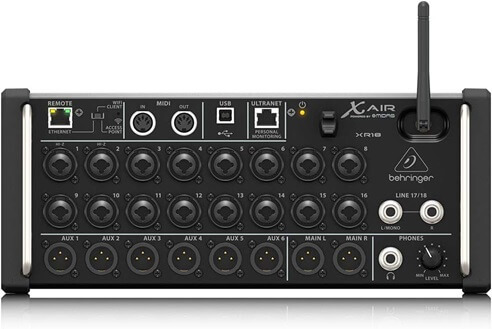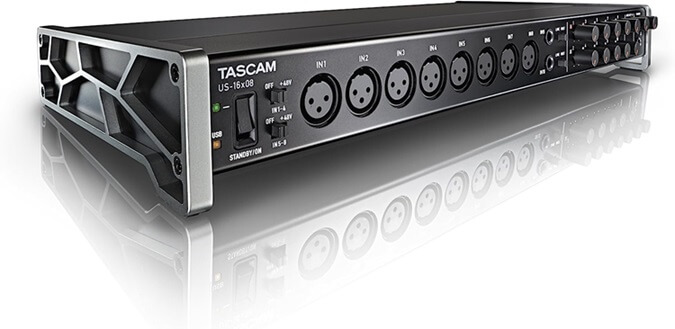A 16-channel audio interface is a device that allows you to connect up to 16 microphones and instruments to your computer. It converts the analog signals from your microphones and instruments into digital signals that can be recorded and processed in your digital audio workstation (DAW).
16-channel audio interfaces are typically used in professional studios, but they can also be used in home studios if you need to record a large number of instruments and microphones at the same time.
Top Features to Look for in a 16-Channel Audio Interface
When choosing a 16-channel audio interface, there are several factors you should consider, including:
- Number of Ports: Make sure the interface has enough ports for the number of inputs and outputs you need. 16-channel interfaces typically have 16 inputs and 16 outputs, but some models may have more or less.
- Impedance: Impedance is the resistance to the flow of alternating current (AC). When choosing an audio interface, it’s important to make sure that the impedance of the interface matches the impedance of your microphone and other input devices. This will ensure that you get the best possible sound quality.
- Phantom Power: Phantom power is a voltage that is sent over the microphone cable to power condenser microphones. If you plan on using condenser microphones, make sure the audio interface you choose has phantom power.
In this piece, we’ve thoroughly examined some of the best 16-channel audio interfaces, outlining their characteristics, advantages, and limitations. Don’t forget to explore the comprehensive “Buying Guide“ section to help you evaluate the items and select the optimal audio interface.
Also Check:
- Best 4-Channel Audio Interfaces
- Best 8-Channel Audio Interfaces
- Best Audio Interfaces for Drums
- Best Audio Interface for Streaming
Outline
ToggleBest 16-Channel Audio Interface Table
| Best 16 Channel Audio Interface | No.of Ports | Impedance | Buy Now |
|---|---|---|---|
| Behringer 16 Channel Audio Interface | 16 | Input-10 ohm Output-50 ohm | Check On Amazon |
| Tascam 16 Channel Audio Interface | 16 | Input-10 ohm Output-100 ohm | Check On Amazon |
| PreSonus 16 Channel Audio Interface | 26 | - | Check On Amazon |
Best 16-Channel Audio Interface Reviews
1. Behringer 16 Channel Audio Interface

One of the most unique features of the XR18 is its revolutionary Dugan-style Auto-Mixing technology. This technology automatically manages microphone gain sharing, which is ideal for multiple-microphone setups such as panel discussions, press conferences, and courtroom proceedings.
The XR18 also comes with four onboard X32 effects engines, which give you access to a wide range of high-end effects such as delay, chorus, dynamics, and reverb. These effects can be used to create professional-sounding mixes without the need for any additional hardware.
Overall, the Behringer XR18 is an excellent choice for anyone looking for a powerful and versatile digital mixer. It is packed with features and offers exceptional audio quality at a very affordable price.
Best Features:
- 18 channels and 12 buses for a wide range of mixing possibilities.
- 16 Midas-designed mic preamps for superior audio quality.
- Built-in tri-mode Wi-Fi router for wireless control.
- 18 x 18 channel, bi-directional USB interface for direct recording to your iPad or PC.
- Revolutionary Dugan-style Auto-Mixing technology for multiple-microphone setups.
- Four onboard X32 effects engines for professional-sounding mixes.
- Affordable price.
Pros:
- Powerful and versatile digital mixer.
- Excellent audio quality.
Cons:
- Some problems with the Wi-Fi connection.
2. Tascam 16 Channel Audio Interface

The Ultra-HDDA microphone preamps deliver pristine sound quality with incredibly low noise and distortion. The two instrument inputs allow you to directly record electric and acoustic guitar and bass without the need for a preamp. The built-in DSP mixer gives you complete control over your monitor mixes, with four-band EQ and compression on each channel.
The Tascam US-16×08 is also incredibly versatile. It can be used as a standalone mic preamp, and it comes with Mac and Windows drivers, as well as USB Class Compliant 2.0 drivers for tablets like Apple’s iPad. This makes it a great choice for musicians, producers, and engineers of all levels.
Whether you’re recording a band, a podcast, or a solo project, the Tascam US-16×08 is a great choice for high-quality audio recording.
Best Features:
- 16 mic and line inputs.
- 8 Ultra-HDDA microphone preamps with −125dBu EIN.
- 8 TRS line level inputs, 2 of which are switchable to instrument level.
- 8 balanced line outputs, 2 with level control on the front panel for monitoring.
- Built-in DSP Mixer for low-latency digital mixing.
- Four-band EQ and compression on each channel.
- Standalone mode for use as a standalone mic preamp.
- Mac and Windows drivers provided, as well as USB Class Compliant 2.0 drivers for tablets like Apple’s iPad.
- MIDI input and output.
Pros:
- High-quality audio recording with the Ultra-HDDA microphone preamps.
- Built-in DSP mixer for low-latency digital mixing.
Cons:
- Can be expensive.
3. PreSonus 16-Channel Audio Interface

One of the most notable features of the StudioLive 16R is its third-generation Fat Channel processing. The Fat Channel provides a full suite of processing options for each channel, including vintage-style EQs and compressors, as well as a limiter and gate/expander. The StudioLive 16R also includes a 6-band, fully parametric EQ on all mix outputs.
The StudioLive 16R is also network-ready, with an AVB Ethernet connection that enables you to network multiple StudioLive Series III mixers and compatible computers. You can also record and stream up to 32 channels of audio to and from a Mac or Windows PC via AVB.
Best Features:
- 18 total inputs, with high-quality XMAX mic preamps.
- 6 FlexMixes (aux mixes, subgroups, or matrix mixes).
- 18×18 USB 2.0 recording interface and 32×32 AVB recording interface.
- Built-in SD card recorder.
- Third-generation Fat Channel processing with vintage-style EQs and compressors.
- 6-band, fully parametric EQ on all mix outputs.
- Network-ready with AVB Ethernet connection.
Pros:
- Powerful and versatile.
- High-quality audio processing.
Cons:
- No motorized faders.
Buying Guide for Best 16-Channel Audio Interface
1. Number of Ports
The first thing to consider is how many inputs and outputs you need. If you’re just recording yourself or a small group, you may only need a few inputs. But if you’re recording a full band or doing complex mixes, you’ll need more inputs and outputs.
Most 16-channel audio interfaces have 16 XLR inputs and 16 TRS line outputs. Some also have additional inputs and outputs, such as ADAT, S/PDIF, and MIDI.
Note: Some audio interfaces usually have 8 proper input channels, the rest of the channels are either outputs, digital, or MIDI interfaces. When we say a “16-channel audio interface” it is sometimes a combination of all these channels.
2. Impedance
Impedance is the electrical resistance of a circuit. It’s important to match the impedance of your microphone or instrument to the impedance of the input on your audio interface. This will ensure that you get the best possible sound quality.
Most audio interfaces have high-impedance inputs, which are designed for microphones and instruments. However, some audio interfaces also have low-impedance inputs, which are designed for line-level signals.
If you’re not sure what impedance your microphone or instrument has, consult the manufacturer’s documentation.
3. Phantom Power
Phantom power is a voltage that is sent to a microphone through the XLR cable. It’s required for some types of microphones, such as condenser microphones.
Most audio interfaces have phantom power switches on each input channel. This allows you to enable or disable phantom power on a per-channel basis.
4. Preamp
The preamp is the part of the audio interface that amplifies the signal from your microphone or instrument to a level that can be recorded and monitored.
The quality of the preamp can have a big impact on the sound quality of your recordings. If you’re serious about recording, you’ll want to choose an audio interface with good-quality preamps.
5. Drivers
Drivers are software programs that allow your computer to communicate with your audio interface. It’s important to make sure that the drivers for the audio interface are compatible with your operating system.
Most audio interfaces come with drivers for both Windows and Mac computers. However, it’s always a good idea to check the manufacturer’s website to make sure that the latest drivers are available.
6. Connectivity
Most 16-channel audio interfaces connect to your computer via USB or Thunderbolt. Some also have additional connectivity options, such as Ethernet and MADI.
Choose an audio interface with a connectivity option that is compatible with your computer.
7. Sample Rates
The sample rate is the number of times per second that the audio signal is sampled. The higher the sample rate, the more accurately the audio signal is captured.
Most audio interfaces support sample rates up to 192kHz. However, some audio interfaces support even higher sample rates, such as 384kHz.
Choose an audio interface with a sample rate that is appropriate for your needs. If you’re not sure what sample rate you need, consult the manufacturer’s documentation for your software.
8. Bit Depth
The bit depth is the number of bits that are used to represent each sample of the audio signal. The higher the bit depth, the more dynamic range the audio signal can have.
Most audio interfaces support bit depths up to 24-bit. However, some audio interfaces support even higher bit depths, such as 32-bit.
Choose an audio interface with a bit of depth that is appropriate for your needs. If you’re not sure what bit depth you need, consult the manufacturer’s documentation for your software.
16-Channel Audio Interface – FAQs
Ans: A 16-channel audio interface offers improved audio quality, enhanced recording capabilities, and versatility in audio production. It’s a valuable tool for musicians, podcasters, and sound engineers.
Ans: Consider your specific needs, budget, and reputable brands in the market. Research and read user reviews to make an informed decision.
Ans: Yes, 16-channel audio interfaces are ideal for podcasting and live streaming, as they allow you to host guests, add sound effects, and create immersive content.
Ans: While a 16-channel audio interface is not essential for every home studio, it provides versatility and room for growth. If you plan to expand your setup and work on more extensive projects, it’s a worthwhile investment.
Ans: In most cases, yes. To ensure seamless communication between your computer and the interface, it’s advisable to install the manufacturer’s recommended drivers.
Conclusion
In the realm of audio production, a 16-channel audio interface is an indispensable tool for capturing the full spectrum of sound. The versatility, quality, and efficiency they bring to your studio cannot be understated. By choosing one of the best 16-channel audio interfaces, you’ll be well on your way to elevating your sound production capabilities.

